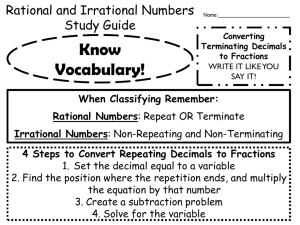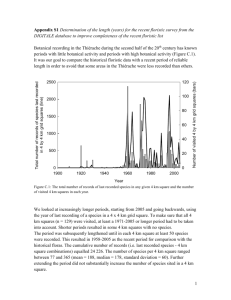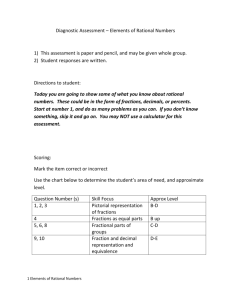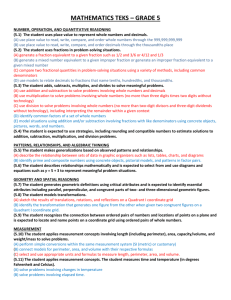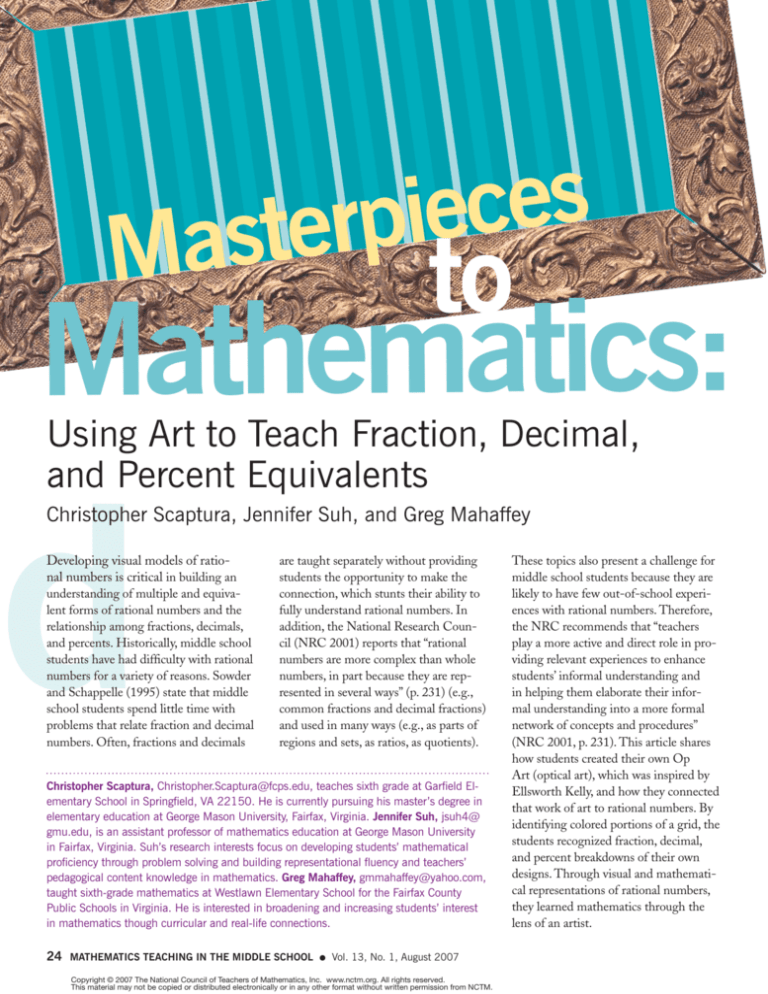
s
e
c
e
i
p
r
e
t
Mas
to
Mathematics:
Using Art to Teach Fraction, Decimal,
and Percent Equivalents
d
Christopher Scaptura, Jennifer Suh, and Greg Mahaffey
Developing visual models of rational numbers is critical in building an
understanding of multiple and equivalent forms of rational numbers and the
relationship among fractions, decimals,
and percents. Historically, middle school
students have had difficulty with rational
numbers for a variety of reasons. Sowder
and Schappelle (1995) state that middle
school students spend little time with
problems that relate fraction and decimal
numbers. Often, fractions and decimals
are taught separately without providing
students the opportunity to make the
connection, which stunts their ability to
fully understand rational numbers. In
addition, the National Research Council (NRC 2001) reports that “rational
numbers are more complex than whole
numbers, in part because they are represented in several ways” (p. 231) (e.g.,
common fractions and decimal fractions)
and used in many ways (e.g., as parts of
regions and sets, as ratios, as quotients).
Christopher Scaptura, Christopher.Scaptura@fcps.edu, teaches sixth grade at Garfield Elementary School in Springfield, VA 22150. He is currently pursuing his master’s degree in
elementary education at George Mason University, Fairfax, Virginia. Jennifer Suh, jsuh4@
gmu.edu, is an assistant professor of mathematics education at George Mason University
in Fairfax, Virginia. Suh’s research interests focus on developing students’ mathematical
proficiency through problem solving and building representational fluency and teachers’
pedagogical content knowledge in mathematics. Greg Mahaffey, gmmahaffey@yahoo.com,
taught sixth-grade mathematics at Westlawn Elementary School for the Fairfax County
Public Schools in Virginia. He is interested in broadening and increasing students’ interest
in mathematics though curricular and real-life connections.
24
Mathematics Teaching in the Middle School
●
Vol. 13, No. 1, August 2007
Copyright © 2007 The National Council of Teachers of Mathematics, Inc. www.nctm.org. All rights reserved.
This material may not be copied or distributed electronically or in any other format without written permission from NCTM.
These topics also present a challenge for
middle school students because they are
likely to have few out-of-school experiences with rational numbers. Therefore,
the NRC recommends that “teachers
play a more active and direct role in providing relevant experiences to enhance
students’ informal understanding and
in helping them elaborate their informal understanding into a more formal
network of concepts and procedures”
(NRC 2001, p. 231). This article shares
how students created their own Op
Art (optical art), which was inspired by
Ellsworth Kelly, and how they connected
that work of art to rational numbers. By
identifying colored portions of a grid, the
students recognized fraction, decimal,
and percent breakdowns of their own
designs. Through visual and mathematical representations of rational numbers,
they learned mathematics through the
lens of an artist.
Connecting Mathematics
with the Art
While searching for an interesting
and effective way to help my sixthgrade students at Westlawn Elementary School in Falls Church, Virginia,
grasp the concept of decimal, fraction,
and percent equivalents, sixth-grade
mathematics teacher Greg Mahaffey
and I discussed several lessons using
the 100 square grid as a way to illustrate portions of a whole. Squares
on a grid immediately made me think
of American artist Ellsworth Kelly, a
twentieth-century painter and sculptor who is recognized and admired
for his contributions to abstract art.
Like many other American artists in
the 1950s, Kelly experimented with
color-field painting. Kelly used a grid
system, placing a variety of warm and
cool colors against one another to
create optical effects on the canvas.
One particular painting from 1951,
titled Colors for a Large Wall, hangs in
the Metropolitan Museum of Art in
New York. He combined 64 solid-colored painted squares into a grid. This
painting inspired me to experiment
with a similar idea with my class.
With help from Jennifer Suh and
Greg Mahaffey, I developed a lesson
based on a grid. Students constructed
their own artwork by gluing small
colored paper squares on a grid.
The Task
In preparing for the lesson, I used a
grid of 100 squares so that students
could clearly visualize and determine
the decimal form (0.01 for each
square) for the amount of each color
used. (See worksheet 1 in fig. 1.)
Students could then calculate their
fraction and percent equivalents. Each
student was required to use at least
three colors of squares. Squares left
blank could be counted as white. I
asked students to choose from a total
of six different colors but ultimately
left the design of the artwork to them.
Since I taught this lesson to four
mathematics sections at the school,
I had to cut 7200 one-inch paper
squares. (This would be an excellent
activity for a willing parent volunteer.)
The cut paper squares had more concentrated color than could be achieved
with pencil or crayon, and the task of
gluing required less time and dexterity
than drawing blocks of color.
Before the students began their
artwork, I introduced the task with
a minilesson on the relationship
between art and mathematics. These
two subjects are not often used in
combination, so I provided concrete
examples of artists’ work that demonstrated this connection. I created a
brief slide show of color-field and opart images by artists like Piet Mondrian, Victor Vasarely, Ellsworth Kelly,
Kenneth Noland, and Frank Stella.
As we viewed these works of art, most
students could see that measurement
Fig. 1 Worksheet 1 that was used in class
NAME _____________________
Color
Number
Vol. 13, No. 1, August 2007
Fraction
●
Decimal
Percent
Mathematics Teaching in the Middle School
25
26
Fig. 3 Ankit produced an intricate
numbers.
design with four colors.
Photograph by Christopher Scaptura; all rights reserved
Students’ Representations
and Mathematical Thinking
Students were given twenty minutes
to design and glue their squares to
the background paper. I created the
background using pencil and paper
and copied the 10 in. × 10 in. grids
onto ledger-sized sheets. These larger
sheets of paper allowed space at the
bottom of the page for a small table
(see the table in fig. 1), divided into
five columns for the categories of color,
number, fraction, decimal, and percent. After completing their designs,
some students counted the number of
squares of each color and computed the
unreduced fraction equivalent based on
the total number of squares (x/100 for
each color). These students then computed the decimal and percent equivalents. When changing from a fraction
to decimal and percent equivalents,
students were able to refer to their grid
and their counted number of colored
squares as a reminder of the equivalent nature of these numbers. Other
students started by finding the decimal
expression for each color, as explained
earlier. As the students finished their
computations, I walked around the
room and questioned them about their
design, mathematical reasoning, and
strategies for checking to see that their
calculations were correct. I reminded
the class that all values in the number
and percent columns should add to
100 and that those in the fraction and
decimal columns should add to 1. For
students who seemed unsure about
the fraction to decimal conversion, I
suggested that they think in terms of
money, with the 100 grid representing
a dollar, and the decimal representing
the equivalent in cents. A few students
Fig. 2 Roberto’s design used “neat”
Photograph by Christopher Scaptura; all rights reserved
and subdivision of the canvas were
hallmarks of this form of abstract
expressionism. I allowed the slide
show to run continually as a source
of inspiration for students while they
worked on their pieces.
discovered errors, but most completed
the calculations without much trouble
or teacher assistance. The table at the
bottom of the page was used to assess
students’ understanding of the concept.
Some students worked methodically in designing a symmetrical pattern with a distinct color and design
(see figs. 2, 3, and 4). Others chose an
abstract form by randomly gluing the
squares on the grid (see fig. 5). Some
students personalized their art by
designing patterns to represent one of
their initials or a smiley face (see fig. 6).
When calculating the total number
of squares used by different colors, the
students who used a color or symmetrical pattern found a numerical-pattern
shortcut. For example, Roberto’s design
used five colors: orange, purple, blue,
red, and green (see fig. 2). His orderly
pattern resulted in “neat numbers” (i.e.,
20 squares = 20/100, or 1/5, 0.20, and
20%). He added each column to check
his work. Ankit also used an equal
number of squares of each color for his
intricate design: pink, blue, green, and
purple (see fig. 3). Therefore, in his
table, he had 25 squares for each color
Mathematics Teaching in the Middle School
●
Vol. 13, No. 1, August 2007
that equaled 25/100, or 1/4, 25%, and
0.25 of the total grid.
Some students wrote the decimal fractions first, then listed other
equivalent fractions (i.e., 36 squares =
36/100 = 9/25, or 4 squares = 0.04 and
4/100 = 1/25). (See fig. 6.)
The students who chose to create a
more random design found that they
needed to be more careful when counting the number of squares for each color.
In fact, some students realized that their
calculations were incorrect when the total
values in a column did not add to 100
percent or 1. They knew that they needed to recount the number of squares for
each color. This built-in, self-checking
format allowed students to verify their
answer without help from the teacher.
Many of my students participate
in the English for Speakers of Other
Languages (ESOL) program, and
a few speak very limited English.
This activity seemed to benefit these
students by allowing them to work on
a visual project and a student-created
manipulative. It helped them communicate and in so doing build confidence
in their understanding of the math-
“neat.” For example, for the blue and
purple squares, he wrote 11/64. By
using the calculator, he was able to
experiment with numbers. Because of
the limited time and the difficulty of
the 64-square grid, Kevin could not
fully check his work. Had he done so,
he would have found that the decimal
column did not add to 1 and the percent column did not add to 100.
To reinforce the relationship
among decimals, fractions, and
percents, I also created a sheet for students to complete as homework (see
worksheet 2 in fig. 7). Unlike the class
project, this homework sheet did not
include the 100 grid. Students were
asked to fill in a table of equivalents
based on one or more numbers from
each set. I included tenths, fifths, and
quarters on the sheet. Students found
the missing pieces easy to determine
without using a calculator. For most of
the numbers, I tried to stay with common values that they might encounter.
I also added an additional column
labeled “equivalent dollar amount” to
reinforce the fact that our monetary
system is based on 100 and correlates
to the 100 grid that they had used in
class. Students demonstrated a high
rate of success on this homework task.
When the students’ artwork was
completed and checked, I displayed
the designs in the hallway outside
of the mathematics room. The grids
made a colorful addition to our school
as well as reinforced the students’ understanding of the relationship among
rational numbers.
Fig. 4 Rocio’s numbers required
Fig. 5 Kevin took on the challenge of
Fig. 6 Quoc obviously found joy in this
several calculations.
the 64 square.
project.
Photograph by Christopher Scaptura; all rights reserved
Concluding Remarks
This activity helped build students’
understanding of the relationships
among rational numbers by seeing
how fractions, decimals, and percents are related. It also stimulated
their interest in Op Art and allowed
them to express themselves artistically. Students engaged in activities
that allowed them to model rational
numbers in various representational
systems: pictorially, verbally, symbolically with numbers, and with physical
manipulatives using the grid and color
squares. Lesh, Post, and Behr (1987)
state that students gain a deeper
understanding of a concept when they
can identify and model a mathematical concept in various representational
Photograph by Christopher Scaptura; all rights reserved
Photograph by Christopher Scaptura; all rights reserved
ematics concepts of fractions, decimal,
and percent. In fact, the cooperating
teacher and I overheard a conversation in Spanish where one student was
explaining to his classmate what each
category represented on the table. He
was saying words like por ciento and
fraccion. We capitalized on that teachable moment to discuss the etymology
of the word per cent. In the 1400s, the
word per cento was used to describe a
percent, or per one hundred. Today, we
abbreviate it to the symbol %.
For a limited number of students
who clearly had an easy grasp of this
concept, we presented them with a
more difficult task by asking them to
eliminate the outside row of squares,
thus limiting the grid to 64 squares.
The students who took this challenge had more difficulty determining decimal and percent equivalents
(see fig. 5). Because the focus of this
lesson was on equivalents, I allowed
students to use calculators, when
needed, to determine percents. Kevin
took the challenge and used five colors
randomly. By using the 8 in. × 8 in.
grid, Kevin was forced to work with
fractions and decimals that were not
Vol. 13, No. 1, August 2007
●
Mathematics Teaching in the Middle School
27
Fig. 7 Worksheet 2 was completed by students.
NAME __________________________
DATE _______________
Fill in the missing percent, decimal, and/or fraction for each of the following:
1
Number of
Squares out
of 100
Fraction
Decimal
Percent
Equivalent
Dollar
Amount
75
3/4
0.75
75%
$0.75
1/5
0.2
2
3
30
4
5
0.3
12/25
48%
60
6
37%
7
8
0.56
44
9
23/25
10
7/10
11
91%
crease the number of colors available
or required when creating the art. To
save money, smaller scale grids could
be used and colored pencils could
replace paper squares.
Students usually have fewer outof-school experiences with rational
numbers than with whole numbers,
making it necessary for teachers to
provide relevant experiences to enhance students’ informal understanding
of fractions, decimals, and percents.
Although combining great works of art
with rational numbers may not seem
like an obvious approach to teaching
mathematics, the designs of masters
like Ellsworth Kelly provide students
with concrete examples of how two
subjects as diverse as art and mathematics connect and work together in
the world beyond the classroom.
Bibliography
systems and have the flexibility to
move from one representational system to another. Principles and Standards for School Mathematics (NCTM
2000) encourages students to represent their mathematical ideas in ways
that make sense to them, even if those
representations are not conventional.
By moving from one representational
system to another, students exercised
flexibility in their thinking and gained
a deeper understanding of a concept.
The lesson was particularly useful
in addressing the needs of the students at Westlawn Elementary School.
A large percent of our students are
second language learners or are living
in poverty. We must address the lack
of background knowledge that some of
these students bring with them to the
classroom. This is especially true in regard to vocabulary and visual memory.
Many visual and manipulative models
can be employed to build conceptual
understanding of decimals and fractions. The power of embedding art into
the model is that students consider the
creation of artwork as the end goal and
28
own the learning as a means to an end.
Thus students build visual knowledge
as well as create visual models in the
process of creating artwork. In addition
to the embedded learning, students feel
greater ownership over a model that
they have created themselves, and this
engenders long-term memories that
can be accessed throughout the school
year and beyond. Students at Westlawn have expanded their models past
equivalent representations of rational
numbers to include greater understanding of ratios and proportion.
The open nature of the task allows
teachers to tailor it to lower or upper
grades and differentiate within classes
by altering the number of squares
in the grid. For younger students,
the table activity could be limited to
counting the number of squares of
each color and expressing these values
as fractions. The same method could
be used with decimals. Older or more
advanced students could work with a
grid of 64, 121, or even 1000 squares.
As with the number of grid squares,
the teacher could also increase or de-
Mathematics Teaching in the Middle School
●
Vol. 13, No. 1, August 2007
Lesh, Robert, Thomas Post, and Merlyn
Behr. “Representations and Translations among Representations in
Mathematics Learning and Problem
Solving.” In Problems of Representation
in the Teaching and Learning of Mathematics, edited by C. Javier, pp. 33–40.
Hillsdale, NJ: Lawrence Erlbaum
Associates, 1987.
Museum of Modern Art. “Colors for a
Large Wall.” www.moma.org/collection/
browse_results.php?object_id=80528.
-. Moma.org/collection.
National Council of Teachers of Mathematics (NCTM). Principles and Standards for School Mathematics. Reston,
VA: NCTM, 2000.
National Research Council. Adding It
Up: Helping Children Learn Mathematics, edited by Jeremy Kilpatrick,
Jane Swafford, and Bradford Findell.
Washington, DC: National Academy
Press, 2001.
Sowder, Judith, and Bonnie Schappelle,
eds. Providing a Foundation for Teaching Mathematics in the Middle Grades.
Albany, NY: State University of New
York Press, 1995. l



